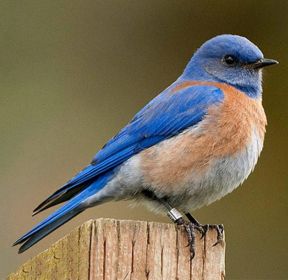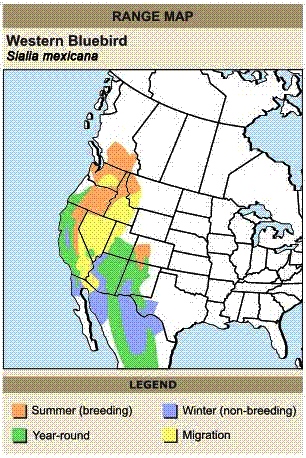
Small thrush with deep blue hood and upperparts, crescent mark across
upper back, red-brown breast, and white belly. Bill, legs and feet are
black. Populations are declining due to competition for nest sites with
European Starlings, Tree Swallows and House Sparrows.
The breeding male Western Bluebird has a deep blue hood and upperparts,
crescent mark across the upper back, red-brown breast, and white belly.
|
WESTERN
BLUEBIRD
Sialia mexicana
PASSERIFORMES
Thrushes (Turdidae)
Range
and Habitat
Breeds from southern British Columbia and western Alberta south to Baja
and east throughout the mountains of the west to eastern New Mexico
and extreme western Texas. Spends winters throughout most of its breeding
range, although northernmost populations usually withdraw slightly southward.
Preferred habitats include open woodlands and pastures where old trees
provide nest sites.
SOUND:
"kew-kew-kew-kew-kew"
Western Bluebirds have suffered from competition for nest sites from
European Starlings and House Sparrows. According to genetic studies,
45% of Western Bluebirds' nests carried young that were not offspring
of the defending male. Swallows have been seen feeding and defending
the nests of Western Bluebirds.
A group of thrushes are collectively known as a
"hermitage" and a "mutation" of thrushes.
The Western Bluebird is a small thrush found in western North America
outside of the desert. This species prefers habitats which include semi-open
country. In winter months, the Western Bluebird migrates to southern
parts of its normal range; however southern populations will remain
permanent residents.
Nests are built in nestboxes or tree cavities, competing with Tree Swallows,
House Sparrows and European Starlings. This bird catches its food by
waiting on a perch and swooping to eat mainly insects. Some insects
are caught in-flight, and this bird will also eat berries.
|




